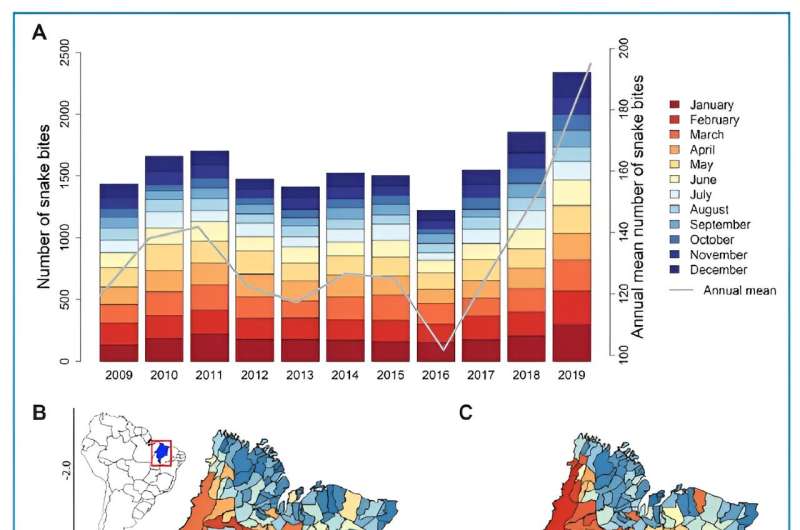This article has been reviewed according to Science X's editorial process and policies. Editors have highlighted the following attributes while ensuring the content's credibility:
fact-checked
trusted source
proofread
Incomplete notification and underreporting of snakebites can hinder public health actions, study suggests

Approximately 28,000 snakebites caused by venomous snakes of medical importance are reported annually in Brazil, according to Health Ministry data. The number is certainly a significant underestimate because many snakebites are not reported.
Underreporting of ophidic accidents (the technical term for poisoning by snakebite), especially in rural areas, is a structural problem in Brazil and other countries. As part of an effort to tackle the problem, notification of snakebites has been mandatory for health clinics and hospitals in Brazil since 1986, and the resulting statistics are key inputs to public health policy actions, such as the production and distribution of antivenoms.
However, a study reported in Revista da Sociedade Brasileira de Medicinal Tropical shows that the requisite forms are not always properly completed and often contain information that is probably incorrect, given the mismatch between the symptoms mentioned and the species named as the cause of the accident.
The article's authors retrospectively analyzed the clinical and epidemiological profiles of snakebites in Maranhão state, Northeast Brazil, between January 2009 and December 2019. According to the study, 17,658 snakebites by venomous snakes of medical importance were reported in Maranhão in the period.
The authors point to a "lack of systematic government planning and adequate training for health professionals to complete compulsory notification forms correctly … at the national and state levels".
"Health workers aren't trained to complete the forms properly, and this hinders the planning of public health policy to address ophidic accidents. Insufficient knowledge of the most common species and symptoms involved is another problem," said Sâmia Caroline Melo Araújo, first author of the article. The study was conducted as part of her master's research at the State University of Maranhão (UEMA).
The authors advocate short-term actions to train health workers to recognize ophidic accidents involving clinically important snake species, provide better care for patients, and complete notification forms correctly. Research in the field will be able to advance as a result.
"The latest data on this topic in Brazil and worldwide is from at least five years ago. The main problem is incompleteness, as snakebites are underreported, not least in Maranhão, which ranks second among Brazilian states in official numbers of ophidic accidents," Thaís Guedes, corresponding author of the article, told Agência FAPESP.
Guedes is a professor at the State University of Campinas's Institute of Biology (IB-UNICAMP), and principal investigator for the project.
Statistics
The analysis showed that 66% of snakebite victims lived in rural areas of Maranhão, where 82% of snakebite accidents occurred. No information on the victims' home addresses or accident locations was included in 2%-3% of the reports. Rural laborer was the occupation stated for 45% of the victims; no information on the victim's occupation was reported in 31% of the cases. Men accounted for 77% of the victims.
The snakes that caused the most accidents were species of the genus Bothrops (lanceheads, 67%), followed by Crotalus (rattlesnakes, 24%).
Micrurus (coral snakes) and Lachesis (bushmasters) each caused 1% of cases.
Feet were bitten in 53% of cases, legs in 21%, and hands in 10%. About 58% of the victims received medical care within three hours, which is roughly the time limit to avoid severe complications and death.
Just over half the cases were classified as mild, and 81% of the victims recovered, but 139 deaths (1%) were recorded.
The researchers found that the severity of envenomation correlated significantly with age, snake genus, and time until the start of medical care. Victims aged 51-60 years were most likely to have severe symptoms, followed by over-60s.
Underreporting of snakebites is a global problem, as already noted. According to the World Health Organization (WHO), the number of snakebite victims worldwide is between 4.5 million and 5.4 million per year, with 1.8 million-2.7 million developing clinical illness and 81,000-138,000 dying from complications. High-risk groups include agricultural workers, herders, fishermen, hunters, working children, and people living in poorly constructed houses.
In the Brazilian study, 45% of the victims stated their occupation to be agricultural workers, followed by school students, with 16%. "A large proportion of the snakebite accidents reported in the period in Maranhão occurred during January and March, when agricultural activity peaks, with a higher probability of encounters between humans and snakes. If all rural workers wore boots, gaiters and gloves, the number of medically important snakebites would drop by as much as 90%, we believe. Proper health care and notification could reduce the number of fatal victims and those with complications," Guedes said.
More information: Sâmia Caroline Melo Araújo et al, Snakebites in Northeastern Brazil: accessing clinical-epidemiological profile as a strategy to deal with Neglected Tropical Diseases, Revista da Sociedade Brasileira de Medicina Tropical (2023). DOI: 10.1590/0037-8682-0224-2023





















